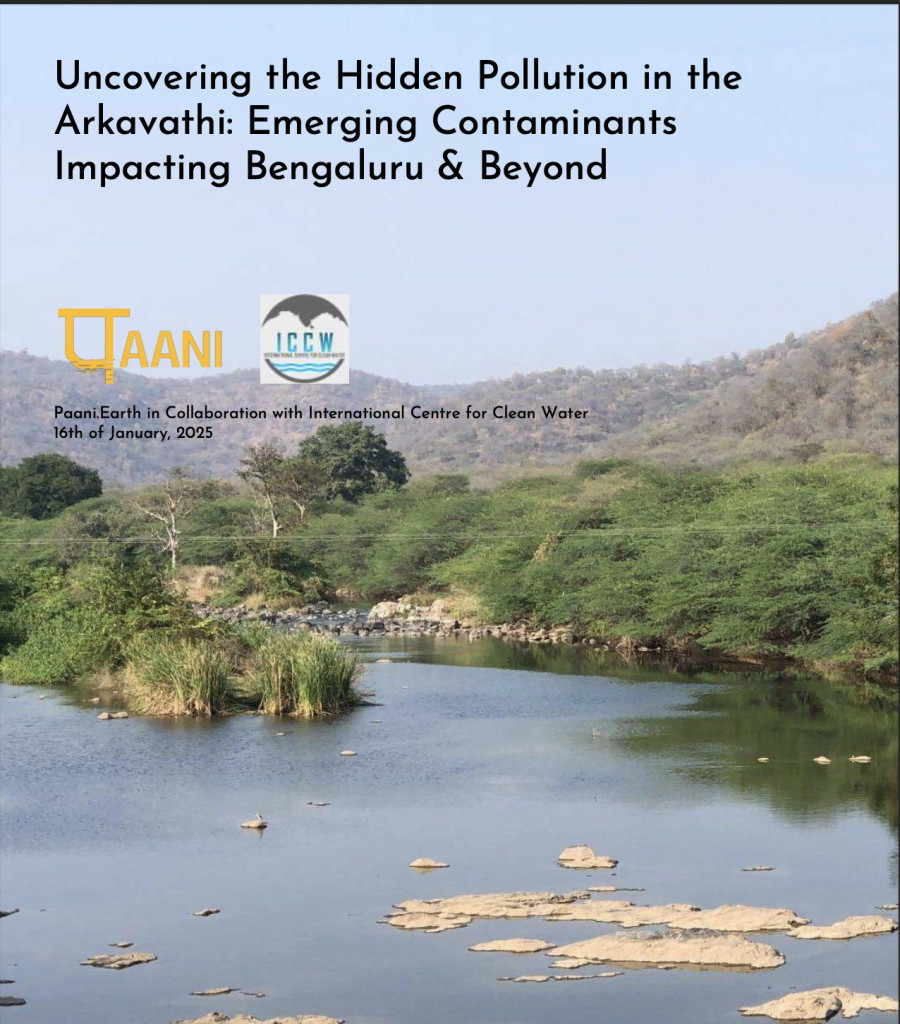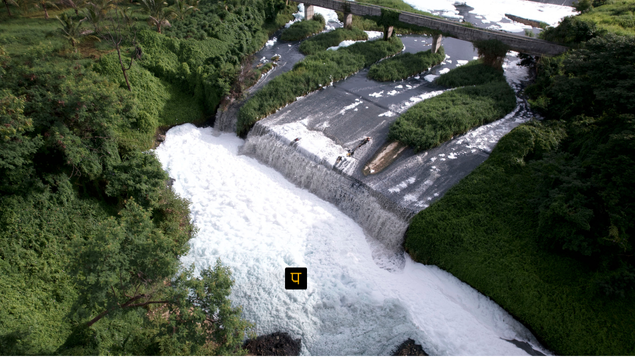Report: Uncovering the Hidden Pollution in the Arkavathi - Emerging Contaminants Impacting Bengaluru & Beyond
Updated Date: 16 Jan 2025
PROJECT CO-ORDINATOR: Madhuri Mandava (For comments/suggestions write to paaniearth@gmail.com)Click Image to load the report
This report summarizes the results of pollution testing along the Arkavathi River conducted by Paani.Earth, in collaboration with the International Centre for Clean Water, in February and March 2024.
The study quantifies the risks of emerging pollutants such as pesticides, hazardous industrial pollutants, and heavy metals by evaluating dry season pollution samples from seven sites along the Arkavathi and its tributary, the Vrishabhavathi River.
Paani tested samples for 65 unique water and 20 unique sediment pollution parameters. This report then compares testing results to national and international standards and guidelines for freshwater and sediment pollution.
- Pesticides: Harmful substances with health impacts such as Heptachlor and DDT found at levels as high as 25022 times United States Environmental Protection Agency guidelines.
- Heavy Metals: Toxins such as Mercury found in sediment at levels up to 26 times above Canada’s Sediment Quality Guidelines.
- Industrial Pollutants: Polycyclic aromatic hydrocarbons (PAHs) from industrial burning such as Dibenz[a,h]anthracene found at 3076 times United States Environmental Protection Agency guidelines.
- Nutrients: Excessive phosphorus levels causing eutrophic conditions at all sites.
Using these results, the study identifies critical pollution trends, including inflows from urban Bengaluru and spikes in select harmful pollutants downstream of industrial areas and quarries, among other sources.
Controlling pollution from point sources and enhancing treatment levels are essential to protect the Arkavathi River and revive Bengaluru’s local water supply. Without urgent intervention, escalating pollution will further endanger human and aquatic health, forcing the city to increasingly rely on distant water sources – Cauvery, Netravathi, and next, Sharavathi. This pursuit of clean water imposes environmental costs, including damage to the ecologically critical Western Ghats, and heavy economic burdens due to rising infrastructure and energy costs.
Is this unsustainable path, both environmentally and economically, the legacy we choose for ourselves?
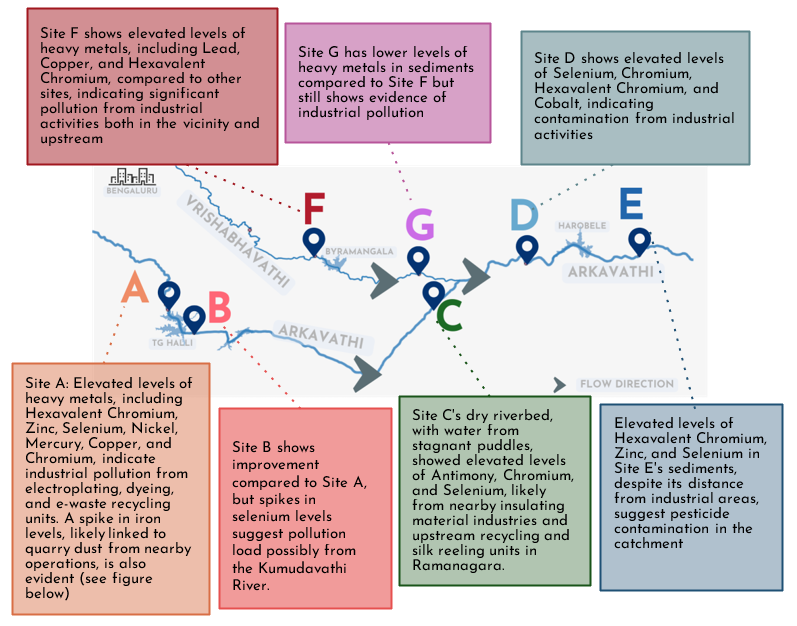
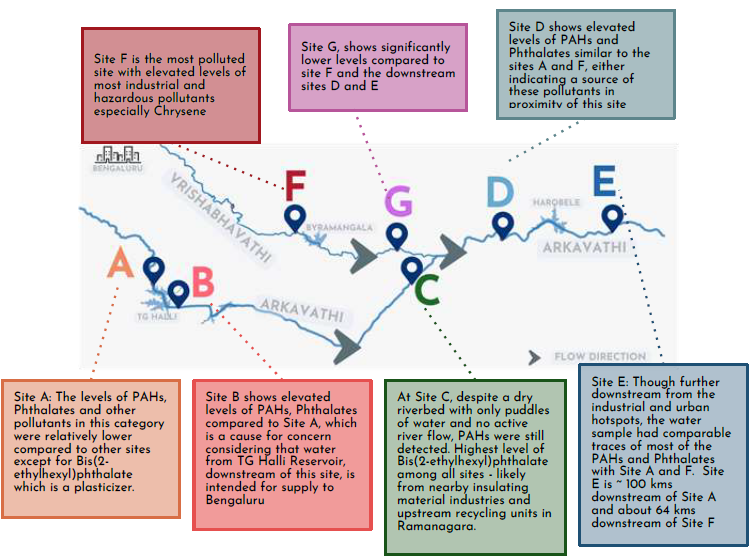
Key Takeaways
Alarming Pollutants:
The Arkavathi River ,and its sediments are contaminated with harmful pollutants, including pesticides (Heptachlor, DDT), heavy metals (Mercury, Chromium), and industrial compounds (PAHs, phthalates). Many pollutants far exceed national and international standards, causing severe risks to human and aquatic health, including cancer and hormone disruption. Heavy metals also contribute to the development of antimicrobial resistance (AMR), posing an additional threat to public health and the environment highlight unregulated industrial pollution as a major driver of the Arkavathi’s pollution crisis.
Widespread Pollution:
Every single test site exhibited pollution values above national and international standards and guidelines. Even remote areas with no visible pollution had high levels of persistent pollutants, highlighting the river’s vulnerability to long-range contamination. Across test sites, Paani observed notable spikes in pollution levels, frequently downstream of industrial areas or other zones with known pollution discharges. Additionally, the results demonstrated that high pollution levels from Urban Bengaluru enter the Arkavathi via the Vrishabhavathi and degrade water quality. Many of the river sites had high phosphorus levels causing eutrophication
Evidence over the years:
Numerous studies, including those by ATREE, highlight unregulated industrial pollution as a major driver of the Arkavathi’s pollution crisis.
Inadequate Monitoring Practices:
Water quality monitoring guidelines of Central Pollution Control Board consider emerging contaminants like pesticides, PAHs, and phthalates, and emphasize the importance of classifying sampling sites to identify and address pollutant sources effectively. However, the Karnataka State Pollution Control Board’s monitoring program under the National Water Quality Monitoring Program (NWMP) falls short. It simplifies the process by assigning sites basic rankings (A, B, C, D, or E) based on limited parameters, failing to account for critical emerging contaminants.
Need for Better Monitoring:
ATREE highlights the need for continuous monitoring to replace the current one-time sampling, which misses changes in pollution throughout the day. Tools like Bhuvan’s Water Bodies Information System (WBIS) and remote sensing can help track water quality in real time. A 2012 ATREE study showed that toxic pollutants peak during the night and early morning, making round-the-clock monitoring essential.
Limited Restoration Plans:
The Arkavathi River restoration plan, developed under the National Green Tribunal’s order to address 351 polluted river stretches, relies solely on BOD values derived from one-time sampling. This narrow focus overlooks the full extent of pollution, minimizing efforts to restore the river comprehensively. Such diluted measures perpetuate high pollution levels impacting aquatic life and public health.
Citizen Asks: Immediate Steps to Secure Our Water Future
Restoring and protecting the Arkavathi and its tributaries – once vital lifelines and now reduced to lifeless drains – requires many actions.
As an urgent first step, we propose these measures to lay the foundation for long-term river health and water security:
1. Strengthen the implementation of the water quality monitoring program to monitor emerging contaminants
“What can’t be measured can’t be improved”. There is clear evidence of industrial pollution and emerging contaminants threatening public health. The water quality monitoring program (NWMP) must be made robust to effectively measure emerging contaminants and other alarming pollutants and address the pollution sources. The water quality raw data and trend analysis should be accessible in the public domain.
2. Mandatory Standards for Phosphates in Detergents:
High phosphorus levels are causing eutrophication in river sites, degrading water quality and aquatic ecosystems. Although BIS standard IS 8180 provides guidelines for phosphate levels in detergents, it is not legally binding. Mandating this standard and introducing economic incentives for manufacturers to comply will significantly reduce pollution. (Source: SANDRP Article Jan 1 2023)
Clean water is vital for life, jobs, and the economy. Without it, industries struggle, jobs are lost, and lives are impacted.
Relying on distant water sources like the Cauvery, Netravathi, and Sharavathi raises costs for infrastructure, energy, and water, straining public funds and burdening the citizens.
Restoring rivers like the Arkavathi isn’t just about protecting the environment – it’s crucial for a healthy economy too.
The Arkavathi River and its tributaries are contaminated and the sources of pollution can be identified. The time to act decisively and stop pollutants at their source is now – a critical step for both our environment and economy.
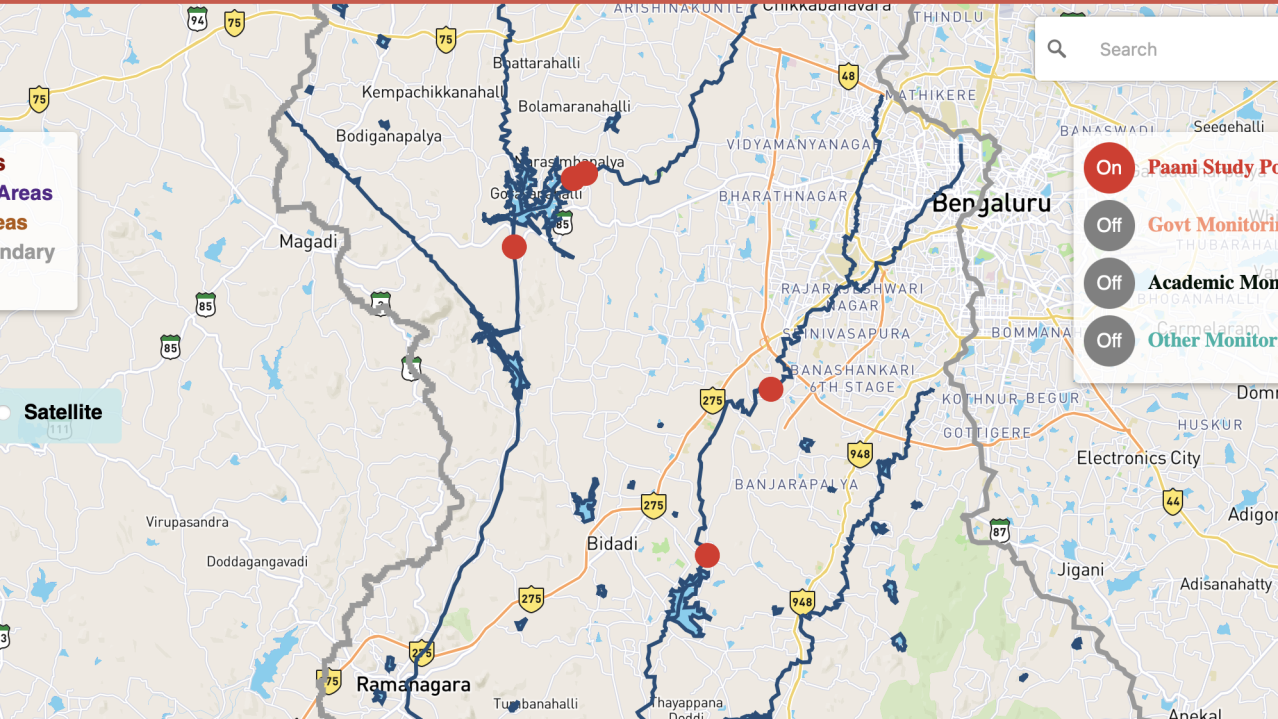
Arkavathi River Basin Pollution Map
An interactive map to help spatially understand the extent of pollution in the Arkavathi River Basin
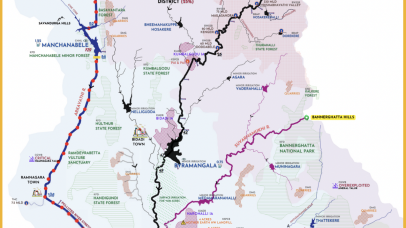
Arkavathi River Basin
A repository of maps, data and analysis on Arkavathi River Basin
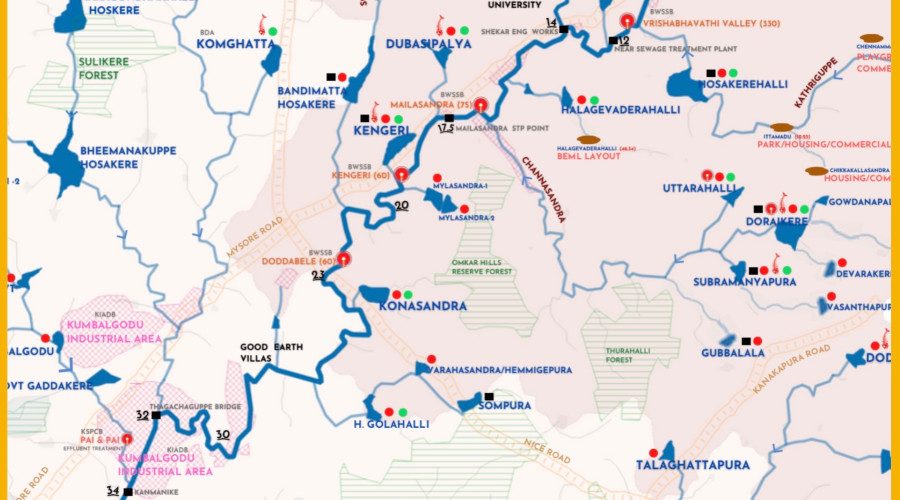
Vrishabhavati River Map
Detailed Map of Vrishabhavati River Basin

RIVER BASIN

DAMS & FLOW

POLLUTION

GROUNDWATER

STRAWS

BIODIVERSITY

RAINFALL FLOODS & DROUGHT

RESTORATION



